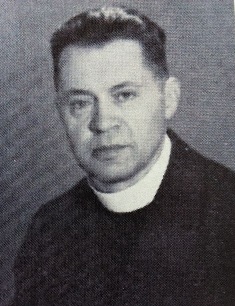Karl Quaß

Personalia
Born:
Died:
Profession:
Persecution:
Imprisonment 12.09.1938 - 26.09.1938,
Imprisonment 26.09.1940 - 16.01.1943,
Dachau concentration camp 16.01.1943 - 26.04.1945
KZ Number:
Memberships
Curriculum Vitae
After graduating from the Bischöfliches Gymnasium in Graz, Karl Quaß entered the seminary in 1912. He completed his philosophical and theological studies at the University of Graz and was ordained a priest in 1916. He then began his pastoral work as a chaplain in the pilgrimage site of Heilbrunn near Naintsch, later in Wies, St. Veit am Vogau, in Puch near Weiz in Styria and later in Pischelsdorf/Strnk. He also studied political science in Graz, which he did not complete, and joined the student fraternity Traungau Graz in 1931. In 1932 he was appointed Provisor of the parish of Mönchegg [today: St. Wolfgang near Obdach in the district of Murtal/Styria] and in 1935 parish priest of St. Wolfgang am Mönchegg. In 1934, he also became a member of the VF.
After the Anschluss, Karl Quaß was sentenced to 14 days of strict arrest on September 12, 1938 for spreading disturbing news because he had allegedly informed some parishioners about the true face of National Socialism. In the spring of 1939, he moved to the parish of Gamlitz (Leibnitz district, Styria). After the outbreak of the Second World War, he made no secret of his political views in this regard and became the target of the local group leader.
In addition, he criticizes Adolf Hitler personally when he points to a picture of the dictator.
This is the gravedigger of Germany, I've never hung it up in my room, it doesn't belong in there either.
Karl Quaß is arrested again after a house search and interrogation on June 29, 1940 and transferred to Leibnitz. On July 4, 1940, Karl Quaß was asked by the episcopal ordinariate to sign a declaration of resignation from his pastorate. On October 4, 1940, he was then sentenced to three years in prison by the special court in Graz in accordance with § 2 of the "Heimtückegesetz". He served his sentence in Graz-Karlau and from August 1941 in Essen/Ruhr (North Rhine-Westphalia). Although he was granted a ten-month reprieve with a five-year probation period on the basis of a clemency decree dated August 20, 1942, he was not released but taken over by the Gestapo and transferred to Dachau concentration camp, where he remained imprisoned from January 16, 1943 until the end of the war. He was liberated on the evacuation march on April 28, 1945.
Places
Persecution:
Place of activity:
Citations
Krause, Peter/Reinelt, Herbert/Schmitt, Helmut (2020): Farbe tragen, Farbe bekennen. Katholische Korporierte in Widerstand und Verfolgung. Teil 2. Kuhl, Manfred (ÖVfStG, Wien) S. 266/267.
Biolex des ÖCV unter https://oecv.at/Biolex/Detail/13901187
